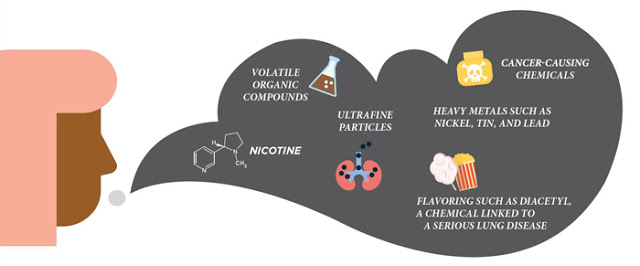Health experts say not to ‘vape’ around children, because the secondhand aerosol (it isn’t vapor) from e-cigs isn’t safe for them

Evolving research shows that electronic cigarettes’ secondhand aerosol (it’s not vapor, despite what the industry says) is not without health risk, and experts warn users to not “vape” around children, Michael O. Schroeder reports for U.S. News & World Report.
“People don’t, I think, always realize that the secondhand smoke emissions from vaping or e-cigarette use can be harmful,” Dr. S. Christy Sadreameli, a pediatric pulmonologist at Johns Hopkins Hospital in Baltimore, and a volunteer spokesperson for the American Lung Association, told Schroeder.
And while she recognized that the debate continues about how the risks of e-cigarettes stack up against traditional cigarettes, Sadreameli added, “We don’t think they’re harm-free, and we don’t think the secondhand emissions are safe for children.”
In addition to nicotine, aerosol from e-cigarettes contain ultrafine particles that can be inhaled deep into the lungs; flavorings, like diacetyl, a chemical linked to serious, irreversible lung disease; volatile organic compounds that are known to be carcinogenic; other cancer causing chemicals; and heavy metals, including nickel, tin and lead, according to the Centers for Disease Control and Prevention.
The experts specifically pointed to the dangers of secondhand exposure to nicotine in children, explaining how the drug can harm kids’ brain development by altering the reward pathways that navigate positive reinforcement. That makes a child more vulnerable, or at increased risk, for becoming addicted to products that contain nicotine and other drugs.
“Exposure to any nicotine or tobacco product is dangerous for infants and children,” Dr. Jonathan Winickoff, the director of pediatric research at the Tobacco Research and Treatment Center at Massachusetts General Hospital, told Schroeder. “The developing brain is exquisitely sensitive to nicotine.”
Schroeder also pointed to a study published in the medical journal Chest in January that found teens with asthma who were exposed to secondhand aerosol, and had not used e-cigarettes, were more likely to have an asthma attack.
“While experts emphasize more study is needed to understand the effects of vaping aerosol, they also reiterate there’s enough potential for harm that parents should never vape around kids – or in spaces like the home or car, where they’ll be,” he writes.
A study published in the medical journal Pediatrics in April, found that while some parents continue to smoke traditional cigarettes around their children, many more reported that they vape around them — “findings [that] seem to underscore an errant perception of e-cigarettes as safe,” Schroeder reports.
“We saw three-fold higher rates of parents using electronic cigarettes inside their homes than smoking,” Winickoff, the senior author of the study, told Schroeder.
“Of the parents interviewed who were dual users, nearly 64% had a smoke-free home policy, compared with only 26%, who had a vape-free home policy,” he writes. “In addition, dual users and e-cigarette-only users together were more likely to have a smoke-free car policy, than a vape-free car policy. Still, only 35% had a smoke-free car policy and just 22% had a vape-free car policy.”
Schroeder also reports on the dangers of “thirdhand” exposure to nicotine and all of the aforementioned substances, which settle on surfaces from the aerosol — just like they do from traditional cigarette smoke.
The experts stressed, “To protect children from secondhand and thirdhand exposure, parents should adopt strictly enforced policies that prohibit e-cigarette use at all times in homes and cars.”